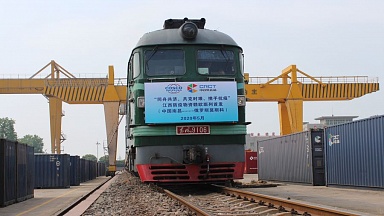A new geography of transcontinental transport and trade is in the making across Eurasia as the «EU-China Express» freight trains have reached in 2020 a landmark transit of half million TEU containers equivalent, an increase of 65% over 2019.
The Trans-Eurasian Rail Corridor has established itself as a new important channel for EU trade with Eurasia and East Asia. The EU stands much to gain in adapting its transport network to this new reality.
The value of goods per rail container from EU to China could be estimated five times those of maritime transport. By end 2020, the volume of containers flows transiting on the «EU-China Express» rail routes has tripled.
Kazakh rail system accommodated most of the 2020 surge, handling 90% transit flows, while major congestion unfolded at the EU eastern borders. Kazakhstan, becoming the main transport hub in the middle of the Eurasian continent, has also turned into the new EU Green Gateway to East Asia.
The rapid expansion of train frequency and container volumes from the Trans-Eurasian freight routes has been causing difficulties at the EU borders. In particular in Poland, through which transit 95% of total " EU-China Express "container freight.
However, another important factor appears to be establishing a balance between east- and westbound rail traffic has been one of the main aims of the operators active on the New Silk Road.
The key importance to establish a smooth path along the freight routes directly between major multi-modal hubs, end destinations in respective economic locomotive regions that can feed cargo delivery hinterland with an efficient capillarity up to final clients has been highlighted for strengthening TEN T Rail Freight Corridors Network. The same principles take even more significance regarding the long distance transcontinental rail routes.
To achieve the EC targets, it appears necessary to concentrate efforts in the priority sections of the 9 Main Transport Corridors where the most significant freight transport volumes (all land transport modes included) are moved.
Another key point is to identify a limited number of strategic socio-economic hubs of this EU Core Backbone Network with the corresponding clusters of main intermodal terminals (strategic terminals) duly linked to intermediate and local terminals.
As the EU embarks on unprecedented overhauling of the "TEN- T Backbone Rail Freight Corridors, it provides also an excellent opportunity to integrate the optimum connections between the Core Backbone Freight Corridor Network and the key «Trans-Eurasian «Express» rail routes in the new «sustainable and smart» scheme.
Engagement and enhanced cooperation by the EU with the Eurasian/East Asian counterparts would be most timely to ensure effectively the building of strong competitive rail connectivity of the EU with China and East Asia across Eurasian space for the coming years.



